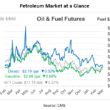Discussions about the newspaper business naturally tend to focus on the “news” rather than the “paper”. But, over the past few years, the cost of that paper (“newsprint”) has become an issue that threatens to accelerate the decline of print and, perhaps, of the scale of many of the brands that have long dominated the media industry.
Earlier this month, Reach Plc – the UK-based tabloid publisher of the Daily Mirror, Daily Express, Daily Star and dozens of local newspapers – blamed the rising cost of newsprint for a 27.4% fall in its operating profit.
Of course, other factors are at play. But a look at the numbers shows the very real problem.
The listed Reach spent £74.5m on newsprint in 2022 – up from £52.9m in 2021, an increase of £22.5m (43%). That accounts for most of the company’s £25.2m increase in operating costs between the two years from £472.9m to £498.1m. And that’s at a time when inflation – and, therefore, most other costs – have also been rocketing.
Other UK publishers offer fewer details about what they spend on newsprint, but almost all have cited similar impacts from rising paper costs. Daily Mail publisher DMGT – which also resells newsprint to other publishers – warned, back in its 2021 annual report, of “increases in the cost of newsprint at levels not seen since 1996”. The regional publisher National World Plc reported this week that its newsprint prices had increased by 67% in 2022.
It is very much a global problem. The largest US regional newspaper publisher Gannett spent $144.1m on newsprint in 2022 – up 37% from $105.5m in 2021. That was despite a 17% decrease in the actual amount of paper it purchased. That shows how the profit impact of lost copy sales and advertising is compounded by newsprint inflation.
Mediahuis, which publishes in various forms across Belgium, the Netherlands, Ireland, Luxembourg and Germany, reported a rise in raw materials costs from €59.3m to €92m (55%) between 2021 and 2022. Much of that is likely, again, to be simply a rise in the cost of the paper its words are printed on.
So, what has caused it all?
Well, while there are certainly unpredictable factors that have ramped up prices for paper. Some sort of significant rise was predictable after a long period where prices had remained low, and in an industry with plenty of long-term contracts.
“It’s important to acknowledge that the period going into 2020 was incredibly benign, prices hadn’t really been going up for quite a long time,” says Enders Analysis chief executive Douglas McCabe. “Industry insiders were expecting at some point around now [that] there was a kind of inevitable moment coming. They knew that, at some point, a wave of price increases would start to happen.”
There are also long-term trends that were always going to apply inflationary pressure on prices for paper, not least the decline in demand for the newsprint itself. Fastmarkets has reported that, “even though newsprint demand continues in a secular decline, the market supply/demand condition remains tight due to mills shutting down or converting capacity, and buyers continuing to worry about receiving enough paper.” In July 2022, it said North American newsprint shipments had declined 14% to 118,000 tonnes year-on-year.
Meanwhile, ever-growing demand for eCommerce packaging also provides competition for paper mill time, albeit for very different kinds of paper product.
All those factors would have led to a big rise in prices. But the unforeseen has also played a role. One of those was, of course, the pandemic, which further increased demand for all that cardboard used by Amazon and the rest of the eCommerce industry to get shiny new goods to bored, stay-at-home consumers.
But even more significant has been the impact of the Ukraine war on energy costs. Of course, those costs have been felt everywhere in the news business, but they have had an even bigger impact on the energy-intensive production of paper.
The perfect storm of factors appears to have caught much of the newspaper business by surprise. “The severity of what happened was not predictable. The speed at which it happened was not predictable, and the longevity of the problem was not predictable,” says McCabe.
The bad news is that, even though the cause of some of these price pressures may be temporary, we may have hit a new “normal” when it comes to paper pricing, even if energy cost reductions start to trickle through.
The whole issue may be be a stark reminder that it isn’t just falling consumer demand for print that may finally see the end of newspapers as a mass medium.
“There comes a point when the industrial scale of print doesn’t quite justify the infrastructure that that exists in the industry,” says McCabe. “The industry, absolutely, should try and extend the length of that industrial period for as long as it possibly can, because it’s still – all things considered – a profitable way of doing business. The end of printed newspapers is still a few years away.
“But at some point, the industry has to come to terms with the fact that it’s going to have to create a different kind of methodology for delivering a much smaller volume base. And I think it will feel very different as an industry.”
Whether or not the new cost of newsprint really will shorten the lifespan of mass printed newspapers, the shock it has caused to the industry at least serves as a reminder that – when the tipping point does come – it may come more suddenly than many expect.




